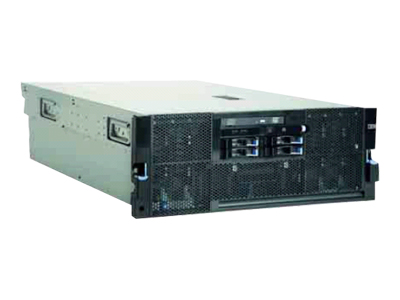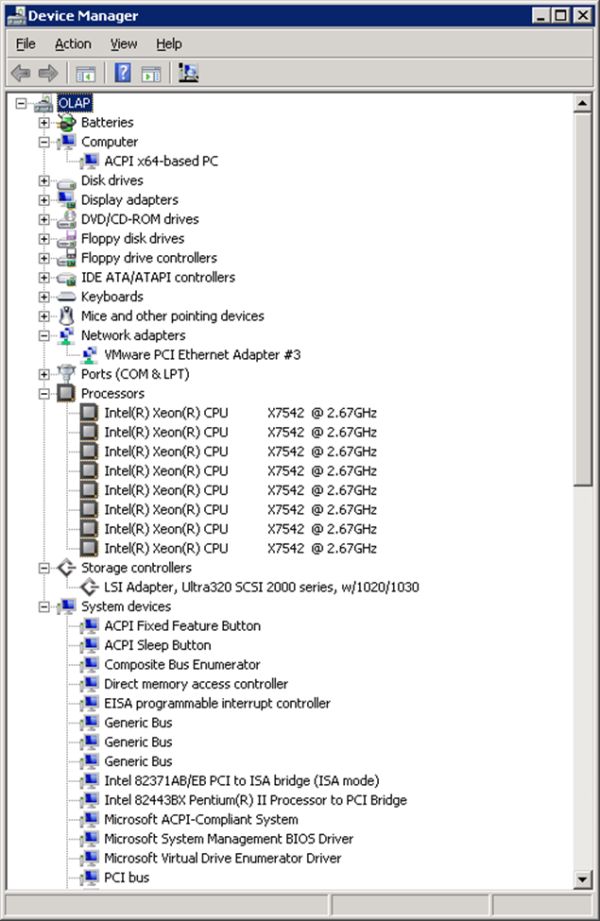Infrastructure as a Service: Benchmarking Cloud Computing
by Johan De Gelas on June 2, 2011 8:50 PM EST- Posted in
- IT Computing
- IT Computing general
- Cloud Computing
The Hardware Behind the Enterprise Cloud
The actual hardware in the Enterprise Cloud is of course a moving target. Terremark claims that every cluster is renewed every three years. In the beginning of 2009, the Enterprise Cloud was based on IBM x3850M2 servers and Fibre Channel IBM System Storage N6040 based SANs. Apparently this would mean that the early Enterprise Cloud was powered by highly clocked Xeon 7400 CPUs. The US based data centers are also using quad Xeon HP DL580 and quad Opteron HP DL585 servers.

Currently, the infrastructure we tested in Amsterdam is based on the Xeon X7542, the highest clock speed “Nehalem-EX” processor. This six-core Xeon runs at 2.67GHz and can Turbo Boost to 2.8GHz.
It is interesting that Terremark chose this particular Xeon. First of all, we have shown that servers based on the fastest Xeons 7500 come with a much lower performance/watt ratio than the Xeon X5600 and Opteron 6100 series. It looks like Terremark decided in favor of raw performance and high availability over power and cost. Second, the Xeon X7542 was not available until Q1 2010, so it is likely that we tested one of the higher performance parts of the Terremark Enterprise Cloud. Terremark claims that all server clusters are replaced every three years, so chances are slim that you will end up with the old Xeon 7400 based servers.
From the customer point of view, that is good news. We don’t have to pay the power bill and the GHz power comes from a raging bull rather than a squawking chicken. If we order 5GHz, it is is more likely that this comes from two 2.5GHz cores instead of 10 500MHz cores. Thus, we expect good CPU performance from this cloud--as you can imagine, we would not be fans of a Sparc T3 based cloud for CPU intensive loads (though network intensive might be better).
A valid concern in a cloud computing environment is that a possible attacker can be on the same network as you behind the same firewall. In other words, somebody could buy some server space to try and attack you. Terremark uses VLAN network partitioning and PCI-compliant firewalls to ensure security.











29 Comments
View All Comments
benwilber - Friday, June 3, 2011 - link
this is a joke, right?there is not one bit of useful information in this article. if i wanted to read a Terremark brochure, i'd call our sales rep.
speaking as an avid reader for more than 12 years, it's my opinion that all these braindead IT virtualization articles are poorly conceived and not worthy of anandtech.
krazyderek - Friday, June 3, 2011 - link
submit a better one thenDigitalFreak - Friday, June 3, 2011 - link
I guess it's a good thing then that your opinion doesn't matter.HMTK - Monday, June 6, 2011 - link
Yeah, I also prefer yet another vidcard benchmark fest.Not.
Shadowmaster625 - Friday, June 3, 2011 - link
Still waiting for that $100 tablet that can provide me a remote desktop that is so responsive you cant even tell it is a remote desktop. I want it to be able to stream video at 480p. With good compression, this only requires a 1 mbps connection. I dont think this is too much to ask for $100. I dont care that much about HD. Streaming a desktop at 30 fps should only require a small fraction of my bandwidth.tech6 - Friday, June 3, 2011 - link
As you mentioned, Terremark cloud benchmarks vary greatly depending on the underlying hardware. We did some tests on their Miami cloud last year and found the old AMD infrastructure to be a disappointing performer. The software is very clever but, like all clouds, some benchmarking and asking the right questions is essential before making a choice.duploxxx - Sunday, June 5, 2011 - link
as usual this is very debatable information you provide. How did you bench and what storage platform? what is your compare a 2008 vs 2010? What kind of application did you bench? Specint? :) Just like Anandtech has greatly shown in the past is that appplications performance can be influenced by the type of cpu (look at the web results within the vApp that is clearly showing it likes faster cache architecture and to certain extend influences the final vApp result to much) you need to look at the whole environment and applications running in the environment, this requires decent tools to benchmark your total platform. (We have more code written by dev to automaticaly test any functional and performance aspect then the applications by themselves) everything in a virtual layer can influence the final performance.Our company has from 2005 till now always verified the platforms between intel and AMD on virtualization every 2 and 4 socket machine. Currently approx 3000 AMD servers on line all on Vmware private clusters from many generations. They are doing more then fine. The only timeframe that the Intel was faster and a better choice was just at launch time of the Nehalem Xeon for a few months. Offcourse one also need to look at the usecase for example the latest Xeon EX is very interesting with huge amount of small vm's, but requires way more infrastructure to handle for example load and the failure of a server. (Not to mention license cost from some 3th party vendors like Oracle.....)
lenghui - Friday, June 3, 2011 - link
A very well thought-out comparison betwen the in-house and IaaS environments. Even those who have the in-house resources would need to spend a lot of research time to reach a conclusion. In that sense, your review is most invaluable -- saving hundreds of hours or otherwise guess work for your readers. You probably can include a price analysis as the other readers have suggested.Thanks, Johan, for the great article.
brian2p98 - Friday, June 3, 2011 - link
This is, imo, the biggest unknown with cloud computing--and the most critical. Poor performance here could result in degradation of performance on the scale of several orders of magnitude. Website hosting, otoh, is rather straightforward. Who cares if 5Ghz of cloud cpu power is equivalent to only 1Ghz of local, so long as buying 25Ghz still makes economic sense?duploxxx - Sunday, June 5, 2011 - link
depends on how good or bad your app can scale with cpu cores.....if it doesn't and you need more vm's to handle the same load you also need other systems to spread the load between apps.